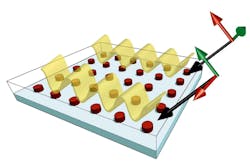Arrays of silicon, rather than metallic, nanoparticles key to improving nanophotonic devices
Resonant nanophotonics show promise in improving the efficiency of photovoltaic cells, LEDs, and photodetectors. Historically, the nanophotonics community has used metallic nanoparticles, where free charges in the particles oscillate after interaction with the electric field of the incoming electromagnetic wave. In recent years, the focus has shifted to nanoparticles made from semiconductor materials such as silicon, where the light interacts with electrons bound to the atom, as opposed to free charges. As for metallic nanoparticles, interactions between light and semiconductor nanoparticles can manifest an oscillatory or resonant response. Researchers at the Eindhoven Institute of technology (TU/e; Netherlands) and the University of Kyoto (Japan) are investigating the use of semiconductor nanostructures for nanophotonics.
A new avenue of research relates to the strong coupling regime, where interactions between light and the nanoparticle materials are strong enough to change the fundamental properties of the material. In fact, a hybridization results where matter assumes some light properties and the light takes on some of the matter properties. When organic materials are used in optoelectronic devices, a key issue is the degradation of the materials when illuminated and the short distance over which charges can propagate. Strong coupling would help to limit these negative effects. Now, the TU/e and Kyoto researchers have achieved a strong coupling for both electric and magnetic oscillations between organic materials and arrays of polycrystalline silicon nanoparticles. They have also shown that regular arrays of polycrystalline silicon nanoparticles that couple to each other can isolate electric and magnetic oscillations. As a result, when dye molecules are close to the arrays, stronger coupling between the dye molecules and the silicon nanoparticle arrays results in enhanced emission of light from the molecules. For instance, a 20-fold enhancement is observed in certain directions when coupled to the electric field of nanoparticle arrays, while a fivefold enhancement results when there is coupling with the magnetic field. This can have implications for the design of future LEDs. References: G. W. Castellanos et al., ACS Photonics (2020), https://doi.org/10.1021/acsphotonics.0c00063 and S. Murai et al., Adv. Opt. Mater. (2020), https://doi.org/10.1002/adom.201902024.
About the Author
John Wallace
Senior Technical Editor (1998-2022)
John Wallace was with Laser Focus World for nearly 25 years, retiring in late June 2022. He obtained a bachelor's degree in mechanical engineering and physics at Rutgers University and a master's in optical engineering at the University of Rochester. Before becoming an editor, John worked as an engineer at RCA, Exxon, Eastman Kodak, and GCA Corporation.

